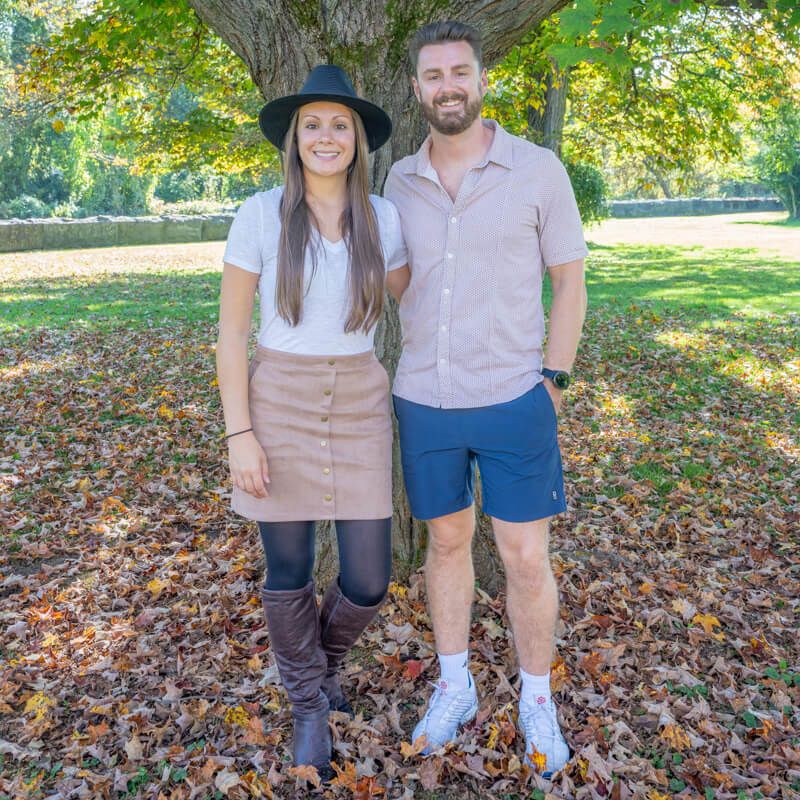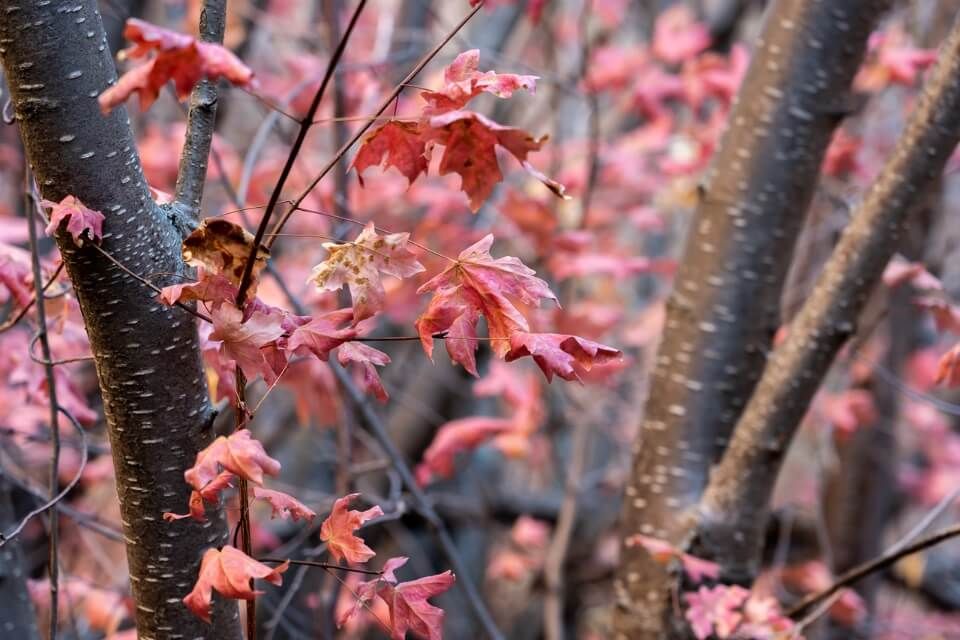Are you trying to figure out the best time to visit Zion National Park? We are going to explain the key pros and cons to visiting Zion in each season with a month by month breakdown, so you can figure out the best time to go based on your personal travel goals.
Are you just planning to take on the best Zion hiking trails any time of year? Or do you want to visit Zion without the crowds of peak season?
Seasonality plays a huge role in your overall experience and we want you to have all the information you need to make the best decision.
So, let’s get stuck into what makes each season of the year the best – and sometimes the worst – time to visit Zion National Park in southwest Utah!
When Is The Best Time To Visit Zion National Park?
Spring and Fall are the best seasons to visit Zion National Park for overall visitor experience, taking into account costs, crowds, weather and lodging.
March, April, October and November offer the most value for money and the least amount of compromises during a visit to Zion.
But we think a Winter visit also has a huge amount of benefits, with very few downsides.
We’ll get into it more in this guide, but personally we think Summer is the worst time of year to visit Zion National Park, due to heavy overcrowding and over-inflated costs.
The most important thing to remember is that Zion is one of the top bucket list USA vacations for millions every year. That means planning ahead and making reservations for hotels, permits and even restaurants in peak season.
How Many People Visit Zion Each Month?
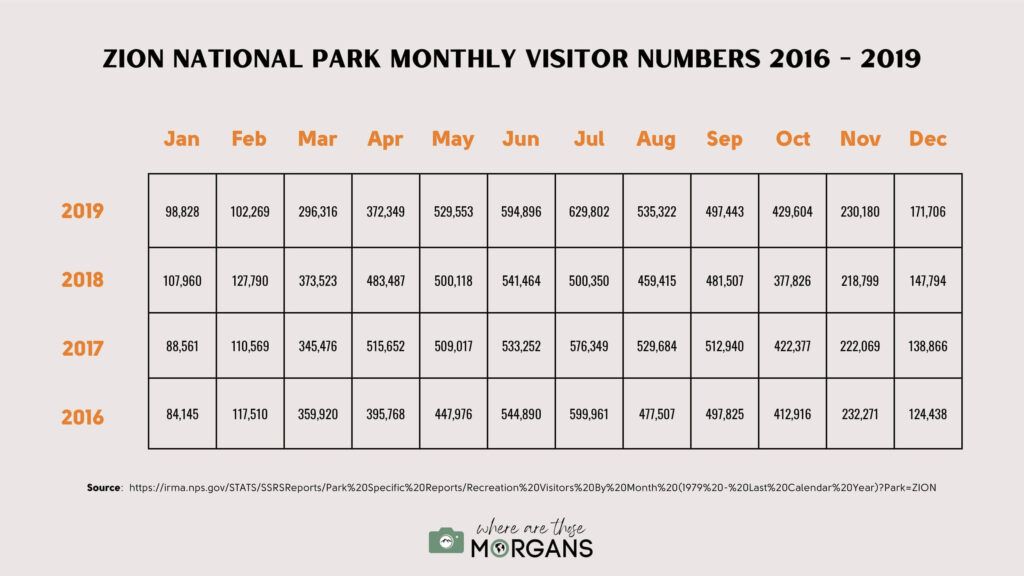
June and July are consistently the two busiest months of the year at Zion National Park. Conversely, January and February are consistently the two quietest months of the year to visit Zion.
However, Zion National Park has a far greater spread of visitors throughout the year when compared to other popular US parks.
For instance, over 50% of annual tourists at Yellowstone National Park visit in the months of June, July and August combined.
In 2019, Zion National Park’s combined visitor number for June, July and August was 1,760,020. That is only 39% of its total 4,488,268 visitors for the year.
But it’s important to remember that Zion National Park is very small in comparison.
Sharing a park the size of Zion with over 550,000 others in June, July and August means competing for hiking trail space, shuttle bus seats and hotel rooms in Springdale.
Note: We only included data up to 2019 because statistics during the coronavirus pandemic are skewed.
Avoiding Crowds In Zion National Park
As you can see in the visitor number infographic above, the Winter months are significantly less busy in Zion National Park year after year.
December, January and February are the best months of the year to visit Zion if you want to avoid overcrowding. Being one of the most popular national parks in the US makes it hard to escape the crowds but Winter does offer some respite.
March and April in Spring, plus October in November are busier than Winter, but far from the severe overcrowding numbers of Summer.
In Summer, the only way you can avoid crowds is by hiking in Kolob Terrace or Kolob Canyons.
Annual Weather Conditions In Zion National Park
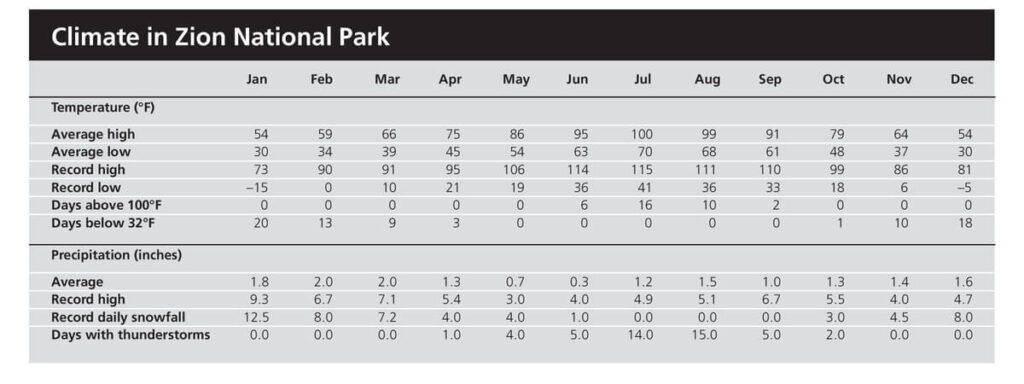
Weather can play an important role in how enjoyable your overall experience is during your visit to Zion National Park, especially if you’re planning to hike exposed trails.
As you can see in the image above showing monthly temperatures and precipitation, conditions are very different between the Summer months and Winter months in Zion National Park.
Key Takeaway Weather Statistics
Let’s take a look at some of the stand out weather statistics in Zion National Park:
- July and August are the two hottest months of the year in Zion National Park.
- January is the coldest month of the year in Zion, but it is closely followed by December.
- Mornings and evenings are cold in Zion from November through March.
- January in Zion offers the best chance of seeing snowfall.
- July and August are very stormy in Zion and can lead to flash floods.
Your Travel Goals
Every visitor will have a different idea of what makes the perfect Zion National Park itinerary.
What does yours look like?
One adventurous hiker may be more interested in the best time of year to hike Zion’s famous trails like Angels Landing, The Narrows and The Subway.
Whereas another visitor might only care about avoiding crowds and getting a parking spot in Springdale.
We’re going to cover all of the most important aspects in the guide so we can help you figure out the best time for you to visit Zion National Park.
Need help planning your trip to Zion?
Our popular Zion travel guidebook helps you with planning every aspect of your visit, including the unmissable hikes, where to eat and stay, itinerary ideas and map!
View Zion Guidebook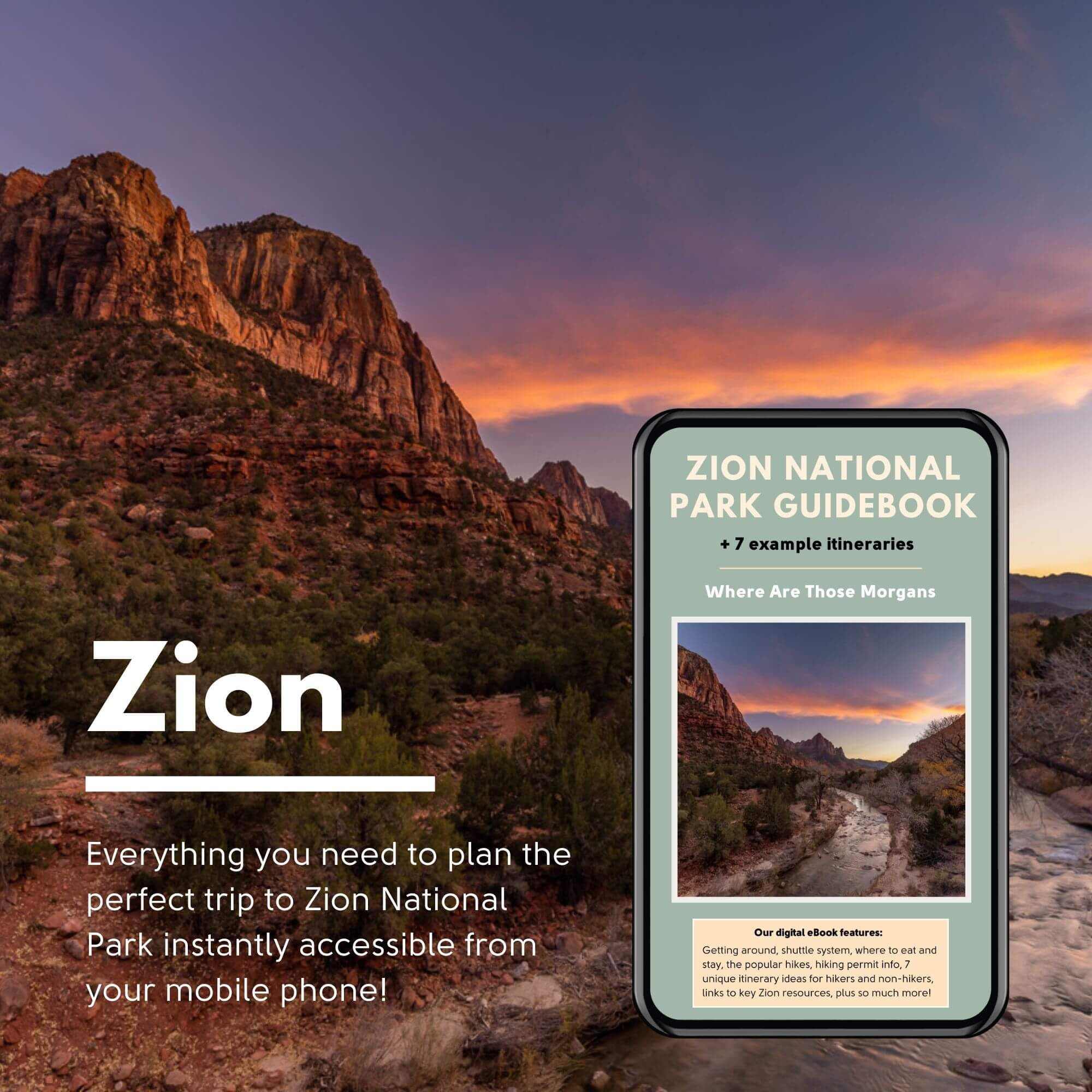
Travel Budget
Visiting National Park’s can get expensive quickly depending on the time of year you decide to visit and Zion is no exception.
Do you have a maximum number you’re willing to spend?
If expenses are something you need to keep a close eye on, you might want to consider shoulder seasons or even Winter and completely rule out a Summer visit to Zion.
Hotel prices in Springdale are eye watering between May and September. But you can find good value between October and April.
Read our helpful guide about where to stay in Zion National Park next for details on the best hotels in Springdale and all other areas near Zion.
Our Typical Considerations
What are some of the aspects we consider when deciding the time of year we want to visit Zion National Park?
- Crowds – Is Zion going to be overcrowded? How important is it to avoid crowds?
- Cost – How much do we want to spend on our visit to Zion? Is the price of a hotel room, flights and rental cars going to justify weather and hiking conditions?
- Weather – Do we need to consider temperatures? Certain hikes in Zion are in water so do we need to weigh up the impacts of seasonality?
- Hiking – Are trails in Zion open? How busy are they in each season?
- Photography – Are we taking our cameras to Zion? Do we need our tripods? What are the conditions like in each season?
- Location – Which other places near Zion are best visited during each season respectively?
- Specifics – What is unique to Zion? Do we need hiking permits? Do we need to book anything in advance?
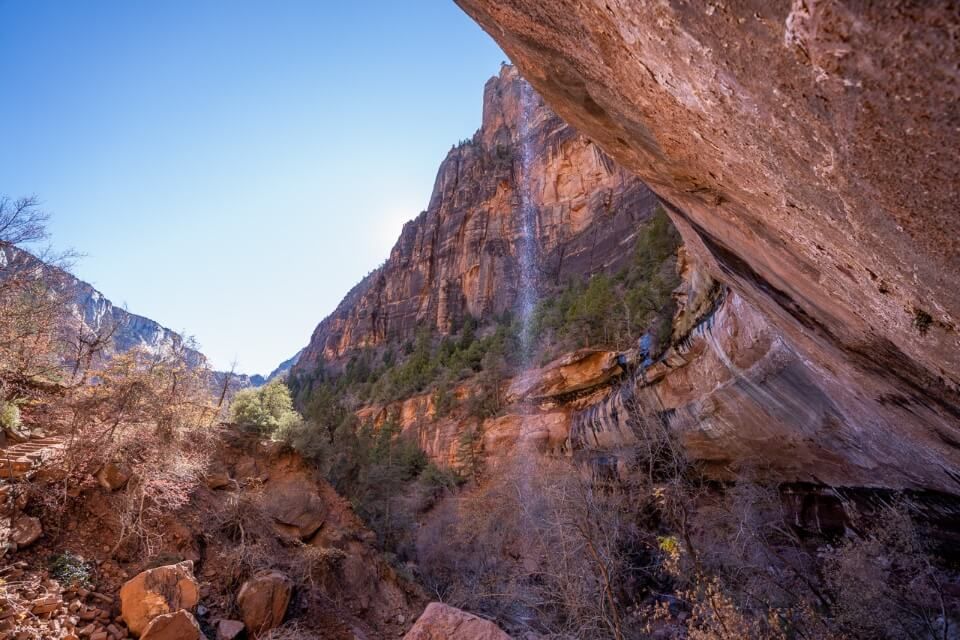
Is Spring The Best Time To Visit Zion National Park?
Spring is one of the best times of year to visit Zion National Park, thanks to more affordable hotel prices, fewer crowds, comfortable weather and perfect hiking conditions.
But there are a number of things you need to be aware of before arriving.
Snow is thawing and snowmelt can cause the Virgin River to flood suddenly. The water is also very cold in early Spring but will warm up toward the latter parts of the season.
This is important because it will impact on your hike into The Narrows, the most popular hike in Zion. You will need to wear the Dry Pants Package from Zion Outfitter or a similar outfitter in Springdale.
However, snowmelt in Spring also means that Zion’s waterfalls on the Emerald Pools Trail will be in full flow. That means you’re going to get the best photos of the year here.
Let’s take a look at typical weather conditions at Zion in Spring.
March Weather In Zion National Park
March is the joint wettest month of the year along with February in Zion National Park. March has an average of 7.2 days of rainfall throughout the month. It also receives half an inch of snow, but it is rare and doesn’t settle for long.
- Average High – 66 F (10 C)
- Average Low – 38 F (-4 C)
- Precipitation – 1.9 Inches
April Weather In Zion National Park
Weather in April is very changeable in Zion National Park, with a sharp decrease in precipitation and amount of rainy days, and a sharp increase in average temperatures. No ‘very hot’ days and low humidity make April a very comfortable month in Zion.
- Average High – 74 F (15 C)
- Average Low – 43 F (0 C)
- Precipitation – 1.1 Inches
May Weather In Zion National Park
Zion’s weather in May takes a huge jump up in average temperatures, second driest month of the year and over 9 days of the month fall into the ‘very hot’ category of 85 F+. Perfect hiking conditions with long daylight hours.
- Average High – 84 F (21 C)
- Average Low – 52 F (4 C)
- Precipitation – 0.6 Inches
Costs In Spring
Zion is springing back to life after a slower Winter season. That translates into hotels starting to increase room prices, flight prices going up and rental car costs increasing.
Early Spring remains very affordable for hotels in Springdale but by the time the end of April and May come around, you can expect to be paying those inflated peak season prices.
Rental cars at Las Vegas and all other airports near Zion National Park are going to be increasing in price throughout Spring, with highest prices in May.
Is Zion National Park Busy In March, April and May?
Crowd numbers in Zion increase exponentially in March, April and May after the quieter Winter season. The increase each month through Spring leading into Summer is very noticeable.
Spring is a very popular time to visit Zion National Park because you can pick up better value flights, rental cars and hotels but also avoid the hottest months of the year.
Spring offers a nice balance between reasonable costs, crowds and weather conditions.
Hiking Zion National Park In March, April and May
Comfortable average high and low temperatures mean Spring is one of the best times of year for hiking in Zion National Park. April and May are excellent months to hike in Zion with warmer mornings and evenings.
However, The Narrows, Taylor Creek Trail in Kolob Canyons and The Subway in Kolob Terrace are more susceptible to flash floods as a result of snowmelt. The same can be said for riverside hikes in Kolob Terrace.
This could mean you can’t hike on the day of your visit. It would be a real shame to miss out on a hike like The Narrows, which is on every Zion itinerary.
On a positive note, you stand a reasonably good chance of winning a lottery permit for hiking to Angels Landing in Spring. Not as many advanced tickets will be snapped up and fewer daily visitors mean a walk in permit is feasible.
Spring is the perfect time to hike all other hikes in the park, from Watchman Trail to Pa’rus Trail in the main canyon and Timber Creek Overlook Trail in Kolob Canyon.
Fewer hikers than the Summer months really does make a difference to your overall experience.
Pros To Visiting Zion National Park In March, April and May
- More affordable hotels versus Summer
- Perfect weather conditions for hiking
- Starts to warm up in the morning and evening
- Better chance of winning hiking permits
- Less crowded than Summer
- Best time of year for waterfall volume
Cons To Visiting Zion National Park In March, April and May
- Not as cheap as Winter
- Busier than Winter
- Flash floods more likely on river hikes like The Narrows
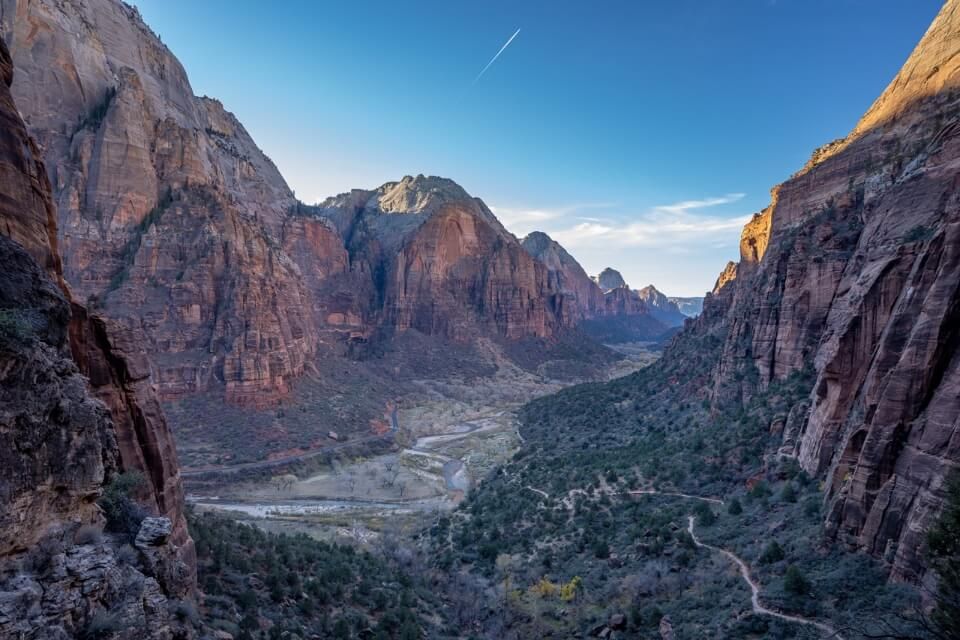
Is Summer The Best Time To Visit Zion National Park?
The Summer months of June, July and August are the busiest times to visit Zion National Park, despite being the hottest, most expensive and most overcrowded time of year.
Families who have to work around school holidays might have no choice, but if you can avoid Summer in Zion, we suggest you do just that.
Yes the weather will be comfortable in the morning and evening, and yes you will have longer daylight hours. But you will also struggle to hike around midday, and you’ll be paying top dollar for transport and hotels.
As we mentioned earlier, we think Summer is the worst time of the year to visit Zion National Park.
Let’s see why!
June Weather In Zion National Park
June is a unique month for weather in Zion with high average temperatures but little humidity and it is the driest month of the year. Likelihood of rain is low and you will have to deal with 23 days in ‘very hot’ conditions. Longest daylight hours.
- Average High – 95 F (27 C)
- Average Low – 60 F (8 C)
- Precipitation – 0.3 Inches
July Weather In Zion National Park
July is consistently very hot in Zion National Park and there’s a huge jump in humidity from June. Average highs of 100 F make hiking difficult in midday but average lows of 67 make mornings and evenings very comfortable. Rainfall increases and storms are frequent.
- Average High – 100 F (29 C)
- Average Low – 67 F (12 C)
- Precipitation – 1 Inch
August Weather In Zion National Park
Second hottest month of the year but rainfall increases versus July and it is the most humid month of the year. Storms are very frequent. August is arguably the most unpleasant month of the year to visit Zion National Park in terms of weather conditions.
- Average High – 97 F (28 C)
- Average Low – 66 F (12 C)
- Precipitation – 1.3 Inches
Costs In Summer
Flights into Las Vegas, St George or SLC are going to be expensive, picking up rental cars at any of those airports is going to be expensive and hotel rooms in Springdale are going to be at their highest price point of the year.
Not only will hotel costs be inflated, but they will also sell out very quickly, so you need to be fast and get your bookings in as early as possible.
Remember you can stay in Hurricane or La Verkin if costs are too high in Springdale but no matter where you stay, you are going to pay borderline ludicrous prices to visit Zion National Park in Summer.
Is Zion National Park Busy In June, July and August?
Crowd numbers peak in June, July and August in Zion National Park. You will be sharing the park, shuttle and Springdale amenities with lots of other tourists if you visit Zion in Summer.
Nearby, many are looking for the best things to do on a visit to Las Vegas. For many, taking a day trip to Zion is a popular choice.
Personally, we would be very reluctant to visit Zion in Summer.
Partly due to the comparatively inflated costs and hotter temperatures resulting in difficulty with hiking. But mostly because it would be crazy busy on every single trail and every night trying to grab dinner in town.
There will be lines for the shuttle bus heading into Zion canyon and you will struggle to get permits for popular hikes.
Even the quieter hikes in Kolob Canyon will be busy relative to the other three seasons in Zion.
Lastly, Springdale does have a good selection of places to eat out. But in Summer you will have to make advanced reservations where possible. Expect daily lines outside of restaurants around lunch and dinner.
We strongly recommend you try to avoid holidays and weekends in Summer.
Hiking Zion National Park In June, July and August
Temperatures can be dangerously high for hiking in Zion National Park throughout Summer. July and August in particular with the added humidity need to be carefully considered on longer and more exposed hikes.
One benefit is that you won’t need to hire any specialist gear for hiking The Narrows. You will still need a pole but the water will be warm enough not to pay $50+ for the waterproof package.
However, along with every other trail in Zion, The Narrows will be jam packed full of tourists which really detracts from the lost world feel you can get here out of peak season.
Plus, you’re really going to struggle getting permits for Angels Landing and The Subway in Summer.
Pros To Visiting Zion National Park In June, July and August
- No gear required for The Narrows
- Warmer mornings and evenings for sunrise and sunset
- Longer daylight hours
- Can swim in pools at the end of The Subway hike
Cons To Visiting Zion National Park In June, July and August
- Frequent storms leading to flash floods
- Exceptionally expensive compared to other seasons
- Need to book hotels months in advance
- Long lines at restaurants each day
- Can become dangerously hot during the day for hiking
- Hiking permits are extremely competitive
- Trails will be jam packed, even in Kolob Canyons
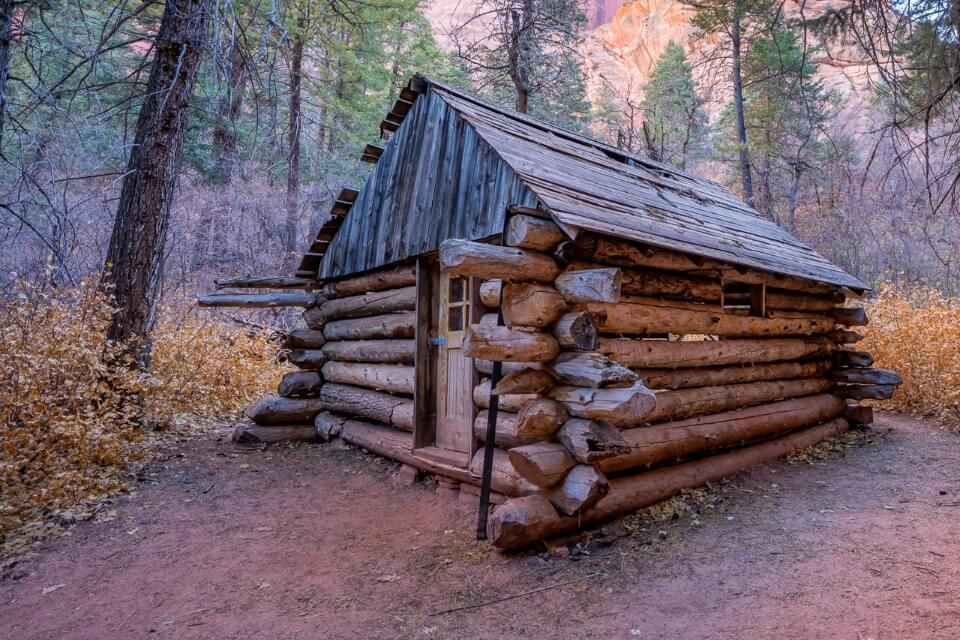
Is Fall The Best Time To Visit Zion National Park?
Comfortable hiking conditions, lower water levels, more affordable prices and fewer crowds in Zion National Park are the reasons Fall is one of the best times of year to visit.
We personally think Fall is the best time of year to visit Zion National Park, once some semblance of normality returns after a crazy Summer season.
October are arguably the very best month of the year to go to Zion. You will experience all of the benefits with very few drawbacks.
Autumn and Spring are very similar in terms of costs, weather and crowds, but Fall does have an edge in the battle of the best shoulder season.
September Weather In Zion National Park
September brings interesting weather conditions to Zion National Park. There’s a drop in rainfall vs August, average temperatures are similar to June, but humidity remains high from Summer despite ‘very hot’ days being significantly less than Summer.
- Average High – 90 F (24 C)
- Average Low – 59 F (8 C)
- Precipitation – 0.9 Inches
October Weather In Zion National Park
October weather in Zion has a significant drop in average high and low temperatures but it is very comfortable. Just 2-3 days will be ‘very hot’, rainfall increases slightly on September but humidity drops heavily. October is one of the best times of year to visit Zion National Park.
- Average High – 77 F (18 C)
- Average Low – 47 F (2 C)
- Precipitation – 1.2 Inches
November Weather In Zion National Park
Average temperatures plummet in November at Zion, most noticeable in the mornings and evenings. Rainfall stays consistent with October and there’s a small chance of snowfall.
- Average High – 63 F (11 C)
- Average Low – 36 F (-3 C)
- Precipitation – 1.2 Inches
Costs In Fall
Hotels in Springdale and surrounding areas begin to lower prices in Fall after the school Summer holidays end. You can find excellent deals in Hurricane and La Verkin as availability begins to open back up, particularly on weekdays.
September will still be pricey but nothing like August. As you get further into October and November you will find prices begin to plummet and you can pick up last minute deals in Springdale.
Rental car prices at nearby airports will gradually decrease through the Fall season and become more affordable by November.
Is Zion National Park Busy In September, October and November?
Fall is another busy season in Zion but it is much calmer and more relaxing compared with Summer. Tourist numbers will begin to diminish in September and continue through Autumn until November when numbers are much lower.
Our first visit to Zion National Park was in October 2019 and we couldn’t believe how crowded it was for the time of year. Avoiding weekends and holidays in Fall will help.
Springdale won’t be as intolerable in the Autumn months but you should still book ahead for meals and hotel rooms where possible. The canyon shuttle should be more easily accessible without lines in Fall.
Hiking Zion National Park In Fall
Fall is the best time of year to hike in Zion National Park with perfect conditions, lowest water levels and fewer crowds.
The Narrows is is going to be quieter in Fall than Summer, and the water might just be warm enough to try without waterproofs in September. In October and November you will need to hire the gear for hiking The Narrows.
You stand a better chance of winning a permit to hike Angels Landing and The Subway, plus all other family hikes in the park are far more relaxing.
All things considered, September and October are both excellent months to be in the Beehive State if you want to hike the best trails in Utah.
Pros To Visiting Zion National Park In September, October and November
- Crowds more manageable after Summer
- Hotels more affordable compared to Summer
- Lowest water levels of the year in The Narrows
- Better chance of winning a permit
- Fall foliage colors in the main Zion canyon
- Perfect weather conditions for hiking
Cons To Visiting Zion National Park In September, October and November
- Colder mornings and evening set back in
- Still not as quiet as Winter
- Water is cold in The Narrows
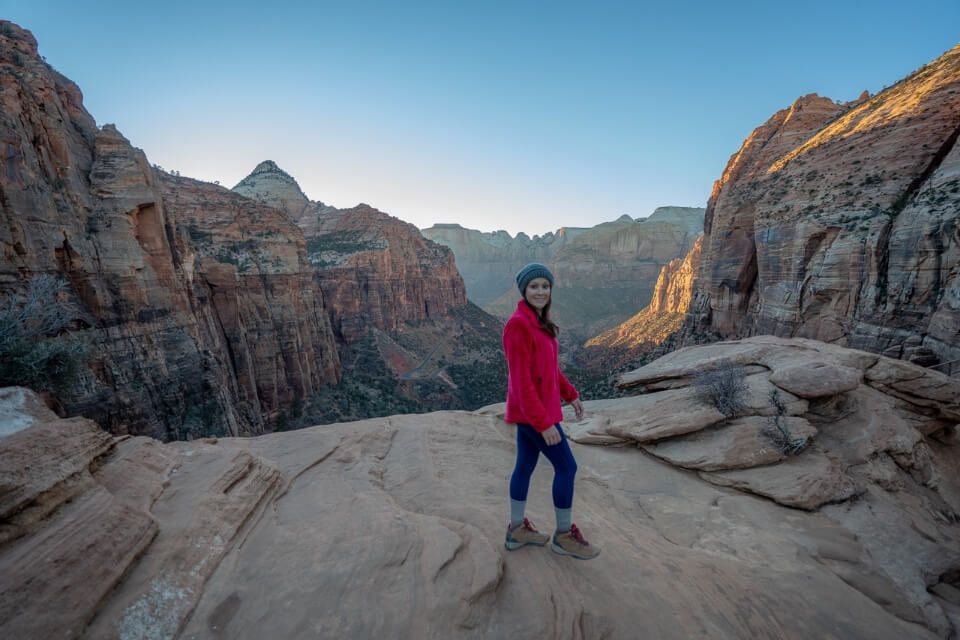
Is Winter The Best Time To Visit Zion National Park?
As Winter descends upon North America, many of the most northerly US national parks transition into a unique Winter season. However, Zion is in southwestern Utah and that means it is accessible year round.
If you’re looking to save money, avoid crowds and have the best chance at getting walk in permits for the most sought after hikes, Winter is the time for you to visit Zion National Park.
We visited Zion in early December 2021 and couldn’t believe how much quieter it was when compared to our October visit. You can read all about it in our comprehensive guide to visiting Zion National Park in Winter.
Another huge benefit to Winter is that you can drive your own vehicle into Zion canyon. Therefore you don’t have to rely on the canyon shuttle.
The only real downside is how cold the mornings and evenings can be during the Winter months.
December Weather In Zion National Park
December is the coldest month of the year in Zion with chilly average lows meaning you need warm layers for mornings and evenings. Highest amount of ‘freezing days’ with temperatures dropping below 32 F (0 C) on 21 days. Lowest humidity but precipitation begins to increase and snowfall may occur but it is rare.
- Average High – 53 F (6 C)
- Average Low – 28 F (-7 C)
- Precipitation – 1.5 Inches
January Weather In Zion National Park
Temperatures at Zion in January are only slightly less cold than December, but January has a little more rainfall and overall rainy or snowy days, with 20 days expected below freezing. Chances of snowfall are the same as December, but again are very rare.
- Average High – 53 F (5 C)
- Average Low – 29 F (-8 C)
- Precipitation – 1.7 Inches
February Weather In Zion National Park
Average temperatures begin to warm up in Zion throughout February versus January, but that also brings the most rainfall and expected rainy days of the year. Snowfall is possible but it is still very rare in February. Amount of freezing days reduces heavily.
- Average High – 58 F (7 C)
- Average Low – 33 F (-6 C)
- Precipitation – 1.9 Inches
Read more about weather conditions in Zion here.
Costs In Winter
The Winter months of December, January and February offer you the chance to see Zion National Park on a low to mid range budget.
Flights, rental cars and hotel rooms are going to be at their lowest price points of the year when compared to any other season. We love to travel when demand is low.
You can pick up last minute deals and you have room to shop around for the best value, as opposed to taking whatever is available.
Want to stay at the top rated hotel in Springdale? You can in Winter!
As long as you don’t mind the cooler weather conditions, Winter is by far the most budget friendly way to experience the best of Zion National Park.
Is Zion National Park Busy In December, January and February?
Zion is incredibly quiet during the Winter months, especially January and February. Hiking trails are more or less empty, which is seldom seen in Zion National Park. Springdale is very quiet and you can walk straight into any restaurant for most of the season at lunch or dinner without reservation.
Saving money on hotels is a huge bonus, but we would sacrifice the cheaper hotel prices just to have the lack of crowds in Zion. Winter gives you both.
You don’t even need to line up for a shuttle because it barely runs in Winter. Instead, you drive your own car to each trailhead inside the canyon.
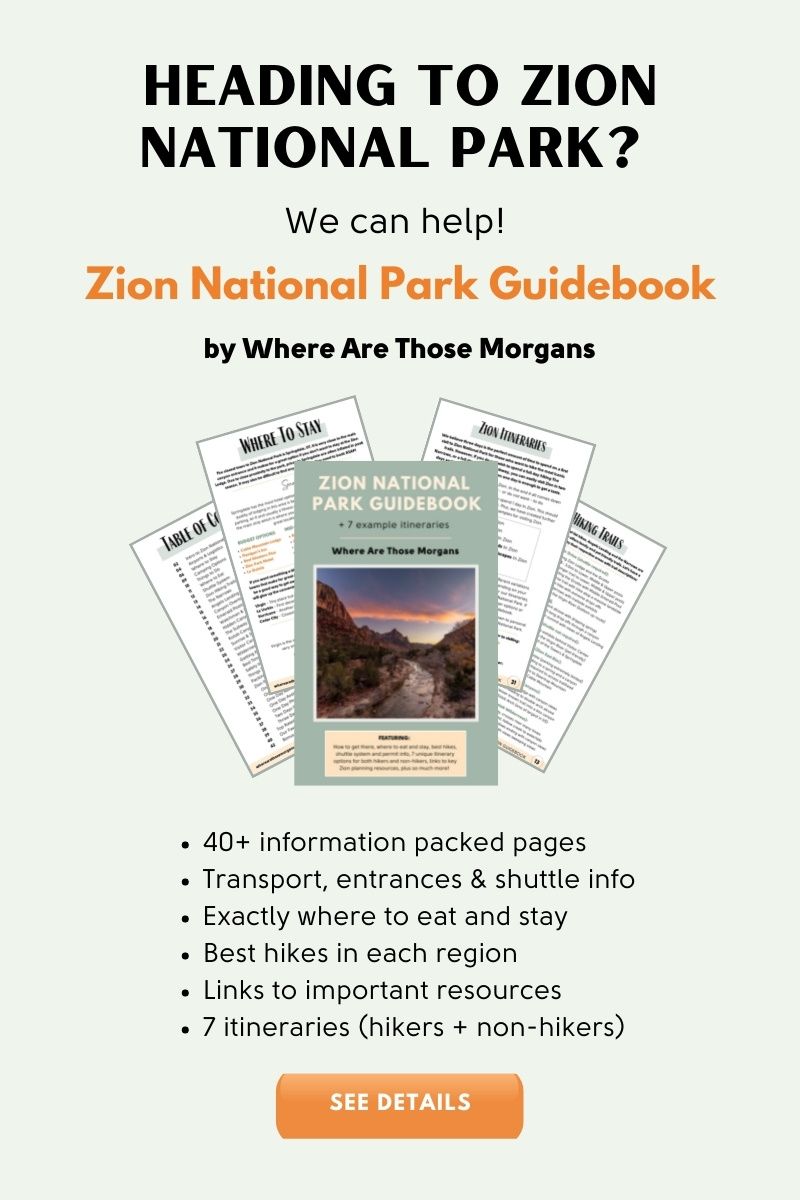
Hiking Zion National Park In December, January and February
Winter is the perfect time to hike in Zion National Park if you want to avoid crowded trails and experience what makes Zion so popular in relative solitude.
You will have to wear warm layers for sunrise or sunset hikes but most days from late morning to late afternoon are going to be warm enough for comfort in lighter middle layers.
Winning next day walk in permits for hiking Angels Landing and The Subway are very realistic in Winter, which is a huge deal.
However, The Narrows will be cold and you will need the full dry pants package. But the overwhelming benefit is you get to experience the famous river slot canyon with barely anyone else around.
Plus, there’s a good chance you’ll have some of the Kolob Canyon hikes to yourself in Winter.
The one thing you need to be aware of is icy or dangerous conditions when hiking in Zion during Winter. Please do not try to hike Angels Landing if there is ice on the ground, it might not end well.
Pros To Visiting Zion National Park In December, January and February
- Quietest time of year by far
- Hotels extremely affordable
- No lines in Springdale restaurants
- Can drive your own car into the main canyon
- Hiking trails are empty
- Good chance of winning hiking permits
- Later sunrise time and earlier sunset time
Cons To Visiting Zion National Park In December, January and February
- Freezing cold mornings and evenings
- Water is very cold in The Narrows
- Less daylight and short days
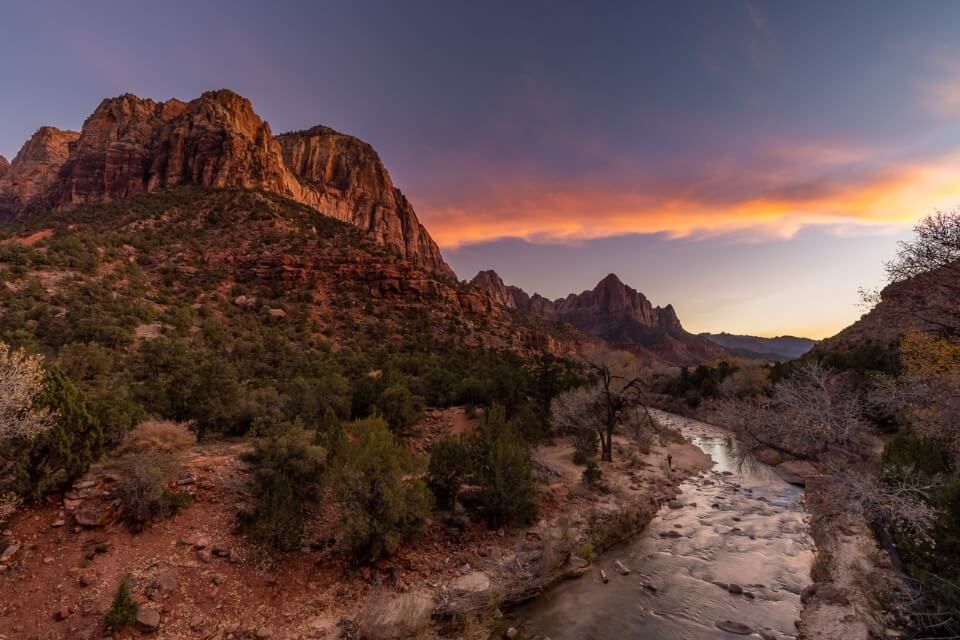
Photography
Zion is an incredibly picturesque and photogenic national park year round. You are not going to struggle to take photos on your visit!
- Summer is going to bring hazy and humid weather to the canyons and that is going to mean your photos might not be as crisp and clear as they might be in Winter, early Spring or late Fall.
- If you strike it very lucky and visit Zion in Winter with a light dusting of snow covering those iconic orange sandstone walls you can take home some rare images from the park.
- High waters in Spring with faster currents may make photography in The Narrows more challenging than lower water and lighter currents in Fall.
- Spring means you get to see waterfalls in full flow at Emerald Pools but Fall allows you to enjoy the radiant beauty of golden leaves on trees in the canyon.
- Finally, sunrise and sunset photography will be most comfortable in Summer with warmer conditions.
So there’s no real best time of the year for photography in Zion National Park, each season has its own pros and cons.
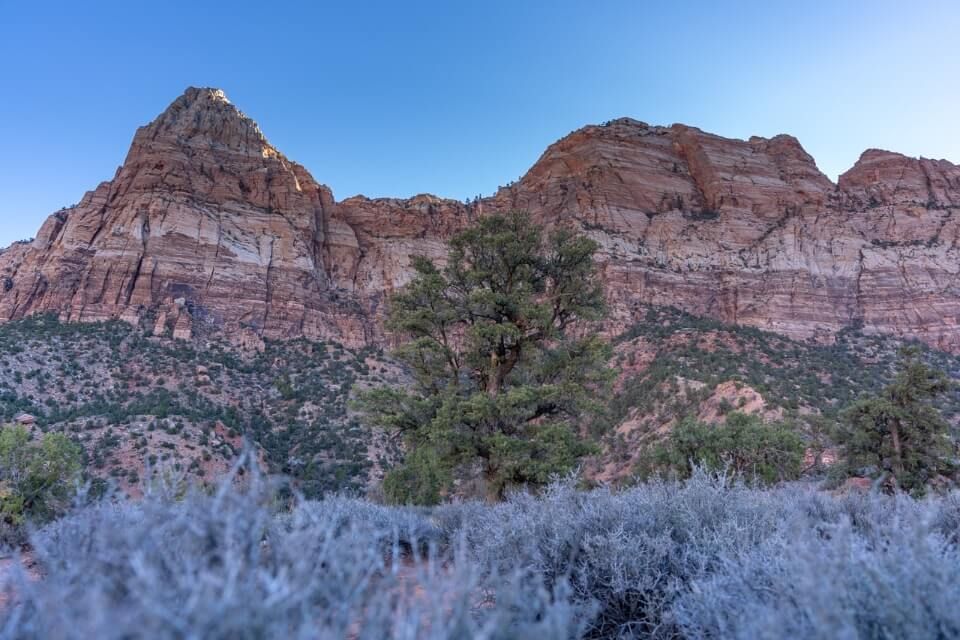
What’s Nearby?
When determining which is the best time of year for you to visit Zion National Park, consider what else is in the immediate area.
Are you going to tie in a visit to Bryce Canyon, Grand Canyon or any of the awesome adventure activities around Kanab?
Which season is the best time to visit those places? Are there any restrictions in those places that might make you reconsider season of visiting?
If you’re just planning to visit Zion, you can ignore this part but it does pay to be as organized as possible if you are visiting any other amazing landscapes in the US southwest on the same trip.
So When Is The Best Time Of Year To Visit Zion National Park?
Winter, Spring and Fall are the best seasons to visit Zion National Park, particularly the months of April and October. They offer the most value for money, fewer crowds and better access to hiking trails.
To summarize: Summer Is Out, Shoulder Seasons Are In.
Well, you need to weigh up your priorities and list them in order of importance.
Lower costs, better access to hiking trails, avoiding crowds or comfortable weather conditions are typical priorities for visitors to Zion.
We think shoulder seasons offer the best compromise between all of the most pertinent aspects.
April, May, September and October just about edge it for the most comfortable months overall. That takes into account warmer weather, reasonable prices, tolerable crowds and decent access to trails.
But Winter could be the winner for many visitors to Zion. It all comes down to sacrificing warm weather to benefit in every other department.
Best Time To Visit Zion For…
- Hikers – Spring, Fall or even some Winter days.
- Photographers – All year but Winter is our favorite.
- Budget Conscious – Winter for the very best deals, but also early Spring and late Fall.
- Families – Late Spring and early Fall for comfortable conditions, slightly lower prices and fewer crowds.
FAQ’s For The Best Time To Visit Zion
Let’s take a quick look at some of the questions people have regarding when to visit Zion.
When Should You Not Go To Zion National Park
Summer is the season to avoid Zion National Park, especially during July and August when temperatures and humidity are high, hotel costs are inflated and hiking trails are overcrowded.
If you’re not bound by school holidays or structured vacation time from your job, avoid visiting Zion in Summer if possible. Any other season is going to be far more enjoyable and won’t break the bank.
Zion is one of the most popular places to visit in Utah. In summer it is overcrowded, expensive and too hot.
What Months Can You Drive Through Zion National Park?
You can drive the Zion-Mt Carmel Highway through Zion National Park year round. However, you can only drive your car into the main Zion canyon in the Winter months of December, January and February, plus the first half of March in Spring.
You can not drive your car into the main canyon from mid-March until the end of November. That means taking a shuttle bus to Angels Landing, The Narrows and Emerald Pools among other popular hikes.
When Should You Go To Zion And Bryce Canyon?
Bryce Canyon is at a much higher elevation compared to Zion National Park, so weather conditions will differ slightly, particularly through the colder seasons. Winter is reasonably comfortable in Zion but it will be significantly colder in Bryce Canyon during December, January and February.
Spring and Fall months of April, May and October are the best months of the year to road trip Zion and Bryce Canyon National Parks when costs, weather and crowds are concerned.
Our Popular Utah Guides
- Itinerary: How many days do you have for your visit to Zion? Here are 5 ways you can plan the perfect Zion National Park Itinerary.
- Hiking: Are you planning to hit the most iconic trails in Zion? Our comprehensive list of the 20 Best Hikes In Zion National Park covers every major hike in all areas of the park.
- Bryce Canyon: Are you planning to visit both Zion and Bryce in Southern Utah? Find out the best way to plan your Zion to Bryce Canyon 3 Day Road Trip Itinerary with two days in Zion and one day in Bryce Canyon.
- Utah: Or are you taking a longer vacation in Utah? We have you covered with 9 Amazing Utah National Park Road Trip Itineraries taking in all of the Mighty 5 national parks and parts of Northern Arizona.
- Top Hikes: Read more about Zion’s three most iconic hikes – How to Hike To Angels Landing In Zion, how to Day Hike The Narrows Bottom Up and how to Day Hike The Subway Bottom Up.
- Airports: Are you flying into Zion? Check out the 4 Closest Airports To Zion National Park to find the best airport to use for your trip.
- Hotels: Are you planning to stay in Springdale? Our popular guide to the Best Places To Stay Near Zion National Park covers the top rated hotels in Springdale, Virgin, La Verkin and Hurricane.
Want more Utah content? Head over to our Utah Travel Guides to explore the Mighty Five National Parks and beyond.
We hope this guide helps you determine the best time to visit Zion National Park!
Please let us know if you have any questions about seasons in Zion below in the comments.
Happy Travels,
Mark and Kristen
Enjoy This Guide? Pin It For Your Visit!
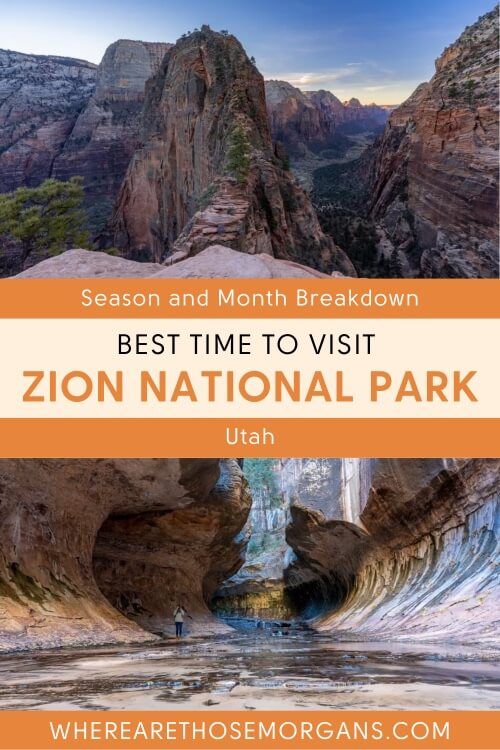
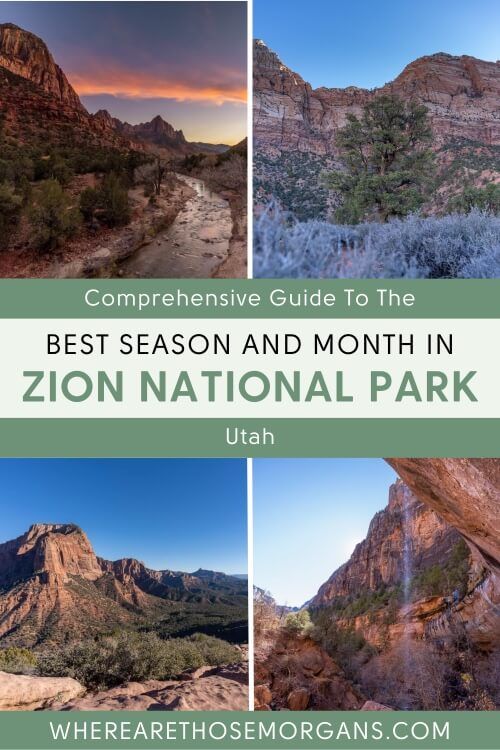
Note: This article contains affiliate links. When you make a purchase using one of these affiliate links, we may earn a small commission at no extra cost to you.
All Rights Reserved © Where Are Those Morgans, LLC. Republishing this article and/or any of its contents (text, photography, maps, graphics, etc.) in whole or in part is strictly prohibited.
Mark and Kristen Morgan are travel, hiking and photography experts. Over the last 6 years traveling full time, they have explored more than 40 countries and 30 US states.
Where Are Those Morgans has been featured in USA Today, Gestalten, Get Your Guide, CityPASS and Condé Nast Traveler along with various other publications. Read more about us.

